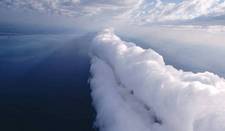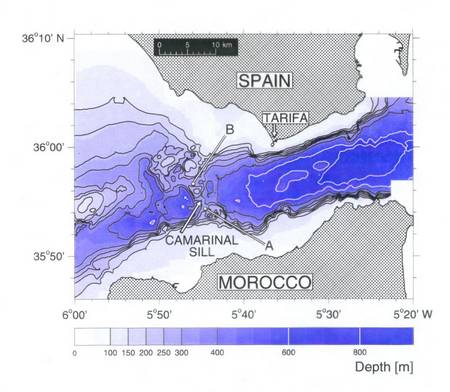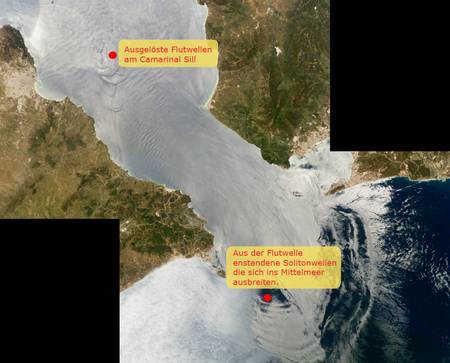Soliton waves in the Strait of Gibraltar / 22nd April 2008
by firmm Team
Text: Elisabeth Kubin, Volunteer at firmm
During today's 17:00 h trip with our firmm boat we were able to experience the famous so-called "Vaciante" waves. We were accompanied by a team from the German Television Station MDR that was taking pictures of the whales and dolphins in the strait of Gibraltar as a part of a travel program with the leading character "Ilse Bähnert".
The Vaciante causes waves that are known in physics under the name of Soliton waves. They do not just occur in solid bodies, but also in rivers, lakes, oceans and also rarely in the atmosphere (e.g.: the "Morning Glory" in Australia - s. photo).

Photo: Morning Glory in Australia, which is also a Soliton wave
Solitons are migrating waves that - once they have been activated - keep on moving constantly with the same wave height and interval. Thus these waves move over a long distance without changing their characteristics.
These waves were first discovered by John Scott Russell in a river. He observed that a wave packet (several waves), that was caused by a boat abruptly stopping didn't subside as usual, but continued running upstream without changing its height, form or interval. He followed the waves upstream on the back of his horse. From that time on, his interest was awaken and he started researching about these waves he called "waves of transition".
There are different ways which such waves might be produced. In the Strait of Gibraltar this happens mainly by the change of high tide to low tide (thus the name). The waves are activated by a higher sill on the Atlantic coast of the Strait and by the narrowness of the Strait. The shallowest area is situated on the Atlantic and Moroccan side and is called Camarinal Sill. The Strait is only 290 m deep at that point.

Figure: topographical map of the Strait of Gibraltar, where you can see the shallowest point, Camarinal Sill.
Source: http://www.ifm.uni-hamburg.de/ers-sar/Sdata/oceanic/intwaves/gibraltar/intro/
The second reason of the formation of such a wave packet is the fact, that there are two main currents in the Strait of Gibraltar: a salted one in high depth, that flows from the Mediterranean Sea to the Atlantic Ocean and another one less salty in the upper 100 - 200 meters, that flows from the Atlantic Ocean to the Mediterranean Sea. This situation results in a Halocline, a salinity gradient (density layer) that separates the salty layer from the less salty one. The depth of the halocline depends on the underground, the currents and the tides.
At the turn of the tides there happens a depression of the density layer. This depression is especially important at the lower sills in the beginning of the Strait of Gibraltar. After the change of the tidal current an intern tidal wave is activated in about 100 m depth. This wave is the beginning of a wave packet of intern Solitons that migrate far into the Mediterranean Sea.

Figure: edited satellite photo of the strait of Gibraltar. Tidal wave activated at Camarinal Sill which leads to solitons that migrate far into the Mediterranean Sea. Source: http://earthobservatory.nasa.gov/Newsroom/NewImages/images.php3?img_id=16581]
These waves may be recognized on the surface as a relatively intense swell. They may also be seen from the outer-space, as in general there is a high concentration of biological films.
As I am very interested in these waves, it was an exciting experience to see these solitons in reality.
